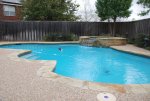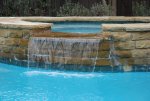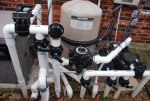My wife and I bought our new house last February, and have had a pool company do all of the maintenance/upkeep on it. My parents had a pool when I was growing up, and I was responsible for the brushing and vacuuming, but my dad and older brother always handled the chemical side of the upkeep. When we bought the house, I didn’t have a clue about how to do anything with the pool (I'm leaning thanks to the pool school here now), so I had my pool company come out and do a “pool school†for me. I mentioned that we were very “green†and wanted to use the least amount of chemicals we could, but still have safe water for our kids (3yr and 7 months now).
The pool tech told us that he would highly recommend we put in an ozonator, as he said it would greatly cut down on the amount of chlorine we would need to keep in the pool. He recommended the Del Eclipse model, which I did a little bit of reading on, and decided to go ahead and put in. He eyeballed the pool and told us it was about a 13,000 gallon pool, so he recommended we get the Eclipse 1. I got the Eclipse 2, with the thought that double the ozone would cut down the pump time and increase the sanitation power of the unit (I believe in bigger is better for most things). The tech said we would save money on electricity with the reduced pump time, which would help cover the cost of the unit. He at first told me that we would need to run about 4 hours or so every day, and that with straight chlorine it would need to be about 8 hours a day.
About two months later, he called me up and told me that the pool company was switching everyone they service to PoolRX mineral packs, and that using the mineral packs along with the ozonator we could cut out the chlorine completely. We didn’t have any chlorine in our pool for about four months, and had perfect looking crystal clear sparkling water. From what I’ve read here, I’m wondering if the water looked clean, but was not really sanitized. They have since discontinued using the mineral packs for everyone but us I believe, they say because of the cost.
About July/August, when we were averaging upper 90s outside, we started getting some algae build up on the steps in the pool. Our weekly tech guy simply shocked the pool to get rid of it. Two days later… it was back. So the next week, another shock, then another shock, then another shock… I was getting a little bit annoyed at the algae coming back so quick, so I asked about it, and they told me that we did actually have to use chlorine in the pool (the guy sounded surprised when I told him we didn’t have any chlorine…), and they added a floater with pucks (not sure if trichlor or dichlor). They also told me I wasn’t running my pump nearly enough, and that I should be running at least 12+ hours a day!!! This was the same guy who told me I would only have to run 4 hours, and no chlorine (which I realize isn’t really an option now). To make matters even more interesting, when we would question the weekly tech (not the same guy who recommended the ozonator/minerals) he looked at us blankly and said that “he didn’t really know what he was doing†when it came to the ozonator, and it seems he’s treating the pool like any normal chlorine pool, keeping the chlorine at 3-5ppm each week.
We have stuck with the Ozonator/Minerals/Chlorine combo, but it kind of seems like a bit of an overkill. The water still looks great, with no clarity or algae issues, but I have no idea what all they are dumping in the water each week when they come out. I’m not home when they are here doing the cleaning, and my wife is busy chasing the kiddos around and doesn’t really know what to ask.
I’m thinking about dumping the pool company, and going at it alone. I ordered the TF100 test kit (XL) to compare to their test results that they leave for me each week. The kit should be here Tuesday, and I’ll post results when I get it.
From what I’ve read, there are very strong feelings both for and against on the ozonators and on the mineral packs. It seems some people don’t feel the ozonators do anything since it isn’t standing water, and that there are concerns the mineral packs stain pools and can cause green hair (copper). I can tell you our ozonator is plumbed on the return, and that it has about 50-60 feet of straight pipe to get to the pool, which I assume gives it time to shock/sanitize the water flowing through that pipe. I’d assume that if I turn over the water each time I run the pump that I’m doing okay on killing whatever is in the water. I understand now that I need to have some residual chlorine in the water for when the pump isn’t running and ozone isn’t being generated.
For the mineral packs, I’m not convinced one way or another that they do anything. It seems some people have said they aren’t compatible with ozonators, as the ozonators kill the minerals (?). I haven’t seen any staining at all, and it’s been about 9 months since we started using the minerals.
So, long story short, do you think the ozone/minerals/chlorine is overkill? Are ozone and minerals really not compatible? If I got rid of the minerals, would I need to add some kind of an algacide, or increase my chlorine? What would a safe level of chlorine be if I took this over myself (0.5-1.0ppm is what I was thinking)? Any other suggestions or thoughts?
The pool tech told us that he would highly recommend we put in an ozonator, as he said it would greatly cut down on the amount of chlorine we would need to keep in the pool. He recommended the Del Eclipse model, which I did a little bit of reading on, and decided to go ahead and put in. He eyeballed the pool and told us it was about a 13,000 gallon pool, so he recommended we get the Eclipse 1. I got the Eclipse 2, with the thought that double the ozone would cut down the pump time and increase the sanitation power of the unit (I believe in bigger is better for most things). The tech said we would save money on electricity with the reduced pump time, which would help cover the cost of the unit. He at first told me that we would need to run about 4 hours or so every day, and that with straight chlorine it would need to be about 8 hours a day.
About two months later, he called me up and told me that the pool company was switching everyone they service to PoolRX mineral packs, and that using the mineral packs along with the ozonator we could cut out the chlorine completely. We didn’t have any chlorine in our pool for about four months, and had perfect looking crystal clear sparkling water. From what I’ve read here, I’m wondering if the water looked clean, but was not really sanitized. They have since discontinued using the mineral packs for everyone but us I believe, they say because of the cost.
About July/August, when we were averaging upper 90s outside, we started getting some algae build up on the steps in the pool. Our weekly tech guy simply shocked the pool to get rid of it. Two days later… it was back. So the next week, another shock, then another shock, then another shock… I was getting a little bit annoyed at the algae coming back so quick, so I asked about it, and they told me that we did actually have to use chlorine in the pool (the guy sounded surprised when I told him we didn’t have any chlorine…), and they added a floater with pucks (not sure if trichlor or dichlor). They also told me I wasn’t running my pump nearly enough, and that I should be running at least 12+ hours a day!!! This was the same guy who told me I would only have to run 4 hours, and no chlorine (which I realize isn’t really an option now). To make matters even more interesting, when we would question the weekly tech (not the same guy who recommended the ozonator/minerals) he looked at us blankly and said that “he didn’t really know what he was doing†when it came to the ozonator, and it seems he’s treating the pool like any normal chlorine pool, keeping the chlorine at 3-5ppm each week.
We have stuck with the Ozonator/Minerals/Chlorine combo, but it kind of seems like a bit of an overkill. The water still looks great, with no clarity or algae issues, but I have no idea what all they are dumping in the water each week when they come out. I’m not home when they are here doing the cleaning, and my wife is busy chasing the kiddos around and doesn’t really know what to ask.
I’m thinking about dumping the pool company, and going at it alone. I ordered the TF100 test kit (XL) to compare to their test results that they leave for me each week. The kit should be here Tuesday, and I’ll post results when I get it.
From what I’ve read, there are very strong feelings both for and against on the ozonators and on the mineral packs. It seems some people don’t feel the ozonators do anything since it isn’t standing water, and that there are concerns the mineral packs stain pools and can cause green hair (copper). I can tell you our ozonator is plumbed on the return, and that it has about 50-60 feet of straight pipe to get to the pool, which I assume gives it time to shock/sanitize the water flowing through that pipe. I’d assume that if I turn over the water each time I run the pump that I’m doing okay on killing whatever is in the water. I understand now that I need to have some residual chlorine in the water for when the pump isn’t running and ozone isn’t being generated.
For the mineral packs, I’m not convinced one way or another that they do anything. It seems some people have said they aren’t compatible with ozonators, as the ozonators kill the minerals (?). I haven’t seen any staining at all, and it’s been about 9 months since we started using the minerals.
So, long story short, do you think the ozone/minerals/chlorine is overkill? Are ozone and minerals really not compatible? If I got rid of the minerals, would I need to add some kind of an algacide, or increase my chlorine? What would a safe level of chlorine be if I took this over myself (0.5-1.0ppm is what I was thinking)? Any other suggestions or thoughts?


 Congrats on the home purchase
Congrats on the home purchase 



